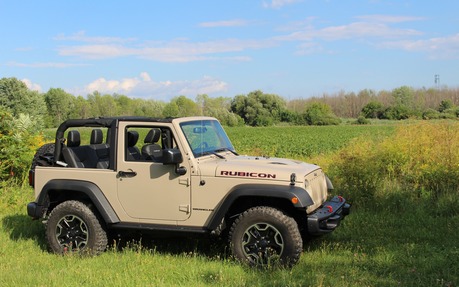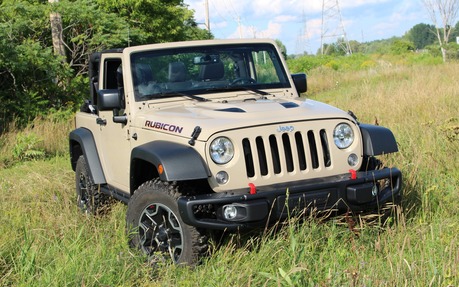2016 Jeep Wrangler Rubicon Hard Rock Edition: (Way) Off the Beaten Path
Ask the owner of a Jeep Wrangler why he or she loves it so much, and you’ll likely get the same answer. “It’s a Jeep thing, you couldn’t understand.”
Apparently, driving an unpractical, inefficient brick of an SUV is a thing that more and more people are discovering, because sales are good in Canada and in the United States, and the Jeep brand is increasing its market share around the globe. Through the first half of 2016, more Wranglers were sold in our country than the Compass, the Patriot and the Renegade combined. Okay, some view those models as not being “real” Jeeps, but you get the picture.
Cross paths with a Wrangler in a Wrangler, and its driver will likely wave at you. You must wave back. That’s part of the “thing.”
What’s surprising, amazing even, is how well the Jeep Wrangler stays primitive, even a little crude, at a time when engine downsizing and eco-friendly practices are the norm. I drive a Wrangler once every two years or so, and every time I anticipate having a good time, hitting the weeds and going where no man has gone before. I usually end up getting stuck, too, but that’s my fault, not the truck’s.
This time around, I chose a two-door 2016 Jeep Wrangler Rubicon Hard Rock Edition, which notably adds unique 17-inch alloy wheels, red tow hooks, extra skid plates and black steel bumpers. Instead of just tooling around town, running through a trail or two and calling it a day, I had a true off-road test planned.
My retired uncle, who watched the adventures of Jungle Jim on television back in the fifties, decided he wanted to become Jungle Jim—and realised his dream 60 years later. He bought a lakeside cabin that he could only reach by boat—after a four-hour drive up north—or with his trusty 1946 Republic RC-3 Seabee amphibious aircraft. The same plane his childhood hero piloted. The cabin has no electricity or running water, and is flanked by an outhouse. The only way he can communicate with the outside world is with a satellite phone, and he has to stand at the very end of the dock to get a hint of reception. He calls this paradise, I call him crazy.
Since last year, thanks to expanded tree cutting in that area, the roads for transport trucks were extended and he can now drive all the way to his cabin. However, the last 500 metres or so, from road to doorstep, needed to be beaten down and he bought himself a two-door, six-cylinder, 1998 Jeep Cherokee to carve a trail through the forest.
He invited me, my girlfriend and my stepson to spend the weekend at his faraway cabin, along with my cousin and two of his three kids. My cousin owns a 2004 Jeep Liberty for weekend activities with the family. We had the makings of a star-spangled, all-Jeep excursion.
I’ll spare the details, but simply put, the Cherokee and the 2016 Jeep Wrangler Rubicon made it back to civilisation, the Liberty did not. After clearing the very challenging rough trail, a rusty lower control arm in the rear suspension snapped. Turns out that component was recalled for excessive corrosion, but hadn’t yet been replaced. Unfortunately for Jeep owners, receiving a constant flow of recall letters is also part of the “Jeep thing.”
Anyhoo, the Wrangler Rubicon performed admirably, allowing a great amount of wheel travel to climb over rocks and stumps as well as overcome nasty tree roots and ruts. The Rubicon edition includes sway bar disconnect and axle lock functions for extra capability, but I didn’t need them. And once we pull away and lift our foot off the clutch pedal with the transfer case in low range, we can simply take our other foot off the throttle and modulate the brakes; the Wrangler will slowly creep along without stalling, which is great when we’re concentrating on the path ahead.
I did scratch one of the Jeep’s allow wheels on a hard rock (drum roll), but I broke with my personal tradition of getting stuck. The Wrangler is still and always the off-road trail champ, despite some rivals having come and gone, such as the Toyota FJ Cruiser and Nissan Xterra. Right now, the Wrangler has no true adversary on the Canadian market.
Off the beaten path, the 2016 Jeep Wrangler is awesome. It’s a life-size Tonka truck, and pulling down the soft top from some sun-soaked, mosquito-packed adventures in the woods is a matter of unzipping the side windows, the rear window, unfastening a couple of latches and pulling the rest of the top down towards the rear of the vehicle.
On the other hand, where the pavement starts is where the fun generally ends.
As a daily driver, the Wrangler is about as enjoyable and comfortable as a farm tractor. Especially in two-door configuration, as the shorter wheelbase gives the Jeep a jittery ride. The numb steering requires constant corrections on the highway. The cabin is quite noisy with the soft top installed. On a happier note, the six-speed manual works surprisingly well, although the long shift lever has the slickness of a broom handle in a bucket full of marbles. Okay, it’s not that bad.
What IS bad is fuel economy. I averaged 14.0 L/100 km over the course of the week, and that includes a few hours of driving on the highway, a little urban cruising and the aforementioned off-road excursion to reach the lakeside cabin. That’s not good. The 3.6-litre V6 doesn’t feel strained by the 4100-lb curb weight of the two-door Rubicon, thanks to its output of 285 horsepower, and provides decent performance. However, if rumours of a hybrid or diesel engine in an eventual, lighter, next-generation Wrangler happen to be true, the fuel bill might not be as high as it is right now.

The two-door 2016 Jeep Wrangler sits four people, and cargo space is virtually nonexistant behind the rear seat. FCA claims a volume of 362 litres, but it feels less than that. I could barely fit a small cooler and a carry-on suitcase back there. Otherwise, flipping down the rear seat opens up a cargo volume of 1600 litres, which is more reasonable. For the daily grind, a four-door Wrangler Unlimited is a better choice, as it sits one more occupant, has a more comfortable ride and more usable cargo space, but it cost $2,500 more than its two-door equivalent.
As you may already know, the Wrangler can be stripped bare by unpinning the doors, detaching the front portion of the roll bar and even folding down the windshield. Like the original 1941 Willys. However, to do this, we need tools and patience, two things I seriously lack. The carpeting can also be removed for a good hose-down. Yet the Wrangler can benefit from features such as a Uconnect infotainment system, heated front seats and leather upholstery.
On the other hand, all this comes at a price. The 2016 Jeep Wrangler starts out at $27,695 before freight and delivery charges, while the Rubicon variant checks in at a rather expensive $40,295. Our Hard Rock Edition Wrangler, which included the Dual Top Group, a towing package, climate control and a 6.5-inch Uconnect system with navigation, carried a nauseating as-tested price of $50,825.
I had a blast driving up to Jungle Jim’s—er, my uncle’s cabin, and the Wrangler is tons of fun off the beaten path. However, unless I’m willing to go off-roading every weekend, enduring the harshness, horrible fuel economy and limited versatility of this good ol’ Jeep on the commute to work and during trips to the grocery store isn’t a sacrifice I’d be willing to make. For the price of a Wrangler Rubicon, I’d choose a well-equipped Cherokee Trailhawk instead.
Indeed, in the case of the Wrangler, I don’t understand this “Jeep thing,” but I respect those who do.
| Test drive report | |
| Test model | 2016 Jeep Wrangler |
|---|---|
| Trim level | Rubicon |
| Price range | $25,995 – $41,495 |
| Price as tested | 50 825 $ |
| Warranty (basic) | 3 years/60,000 km |
| Warranty (powertrain) | 5 years/100,000 km |
| Fuel economy (city/highway/observed) | 14,2 / 11,0 / 14,0 L/100km |
| Options | Hard Rock Edition package ($6,195), Dual Top group ($2,395), Uconnect 430N with navigation ($1,225), trailer tow package ($500), automatic climate control system ($225) |
| Competitive models | Nissan Xterra, Toyota FJ Cruiser |
| Strong points |
|
| Weak points |
|
| Editor's rating | |
| Fuel economy | Even on the highway, the Wrangler sucks down unleaded at a concerning rate |
| Comfort | Adequate seats, but the two-door Wrangler’s ride is jittery |
| Performance | Good hustle from the 3.6-litre V6, although the Wrangler is no featherweight |
| Infotainment | The Uconnect 6.5 system is easy to use, not as slick as the Uconnect 8.4 that’s offered in other FCA products |
| Driving | Off the beaten path, the Wrangler is a champ |
| Overall | The Wrangler makes no sense as an everyday vehicle, but it’s an awesome weekend warrior |
